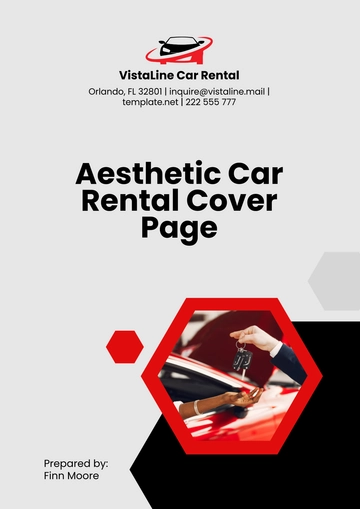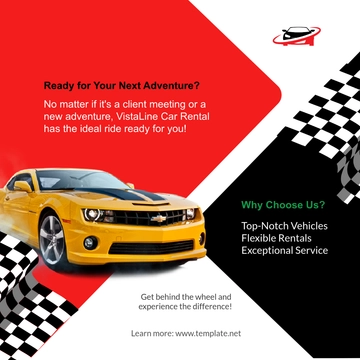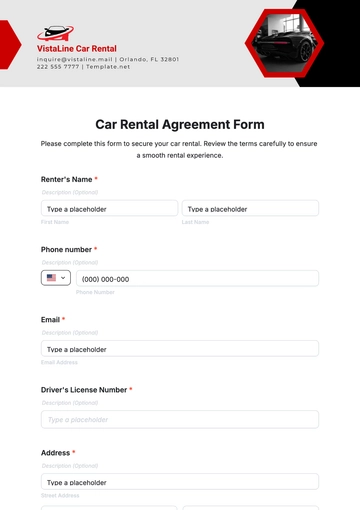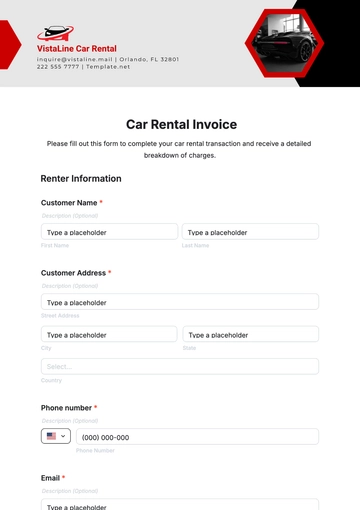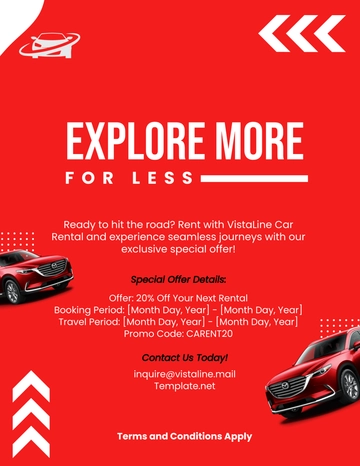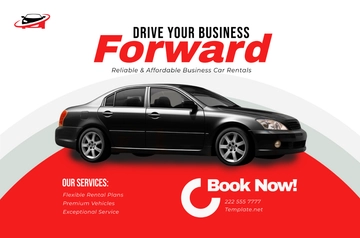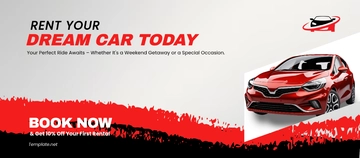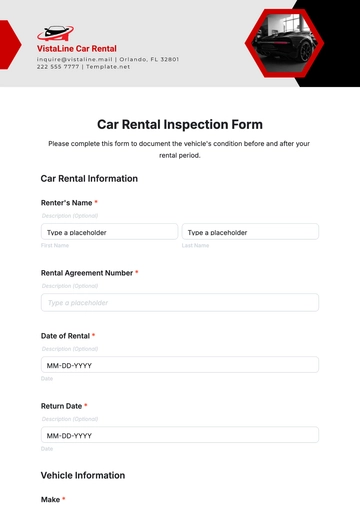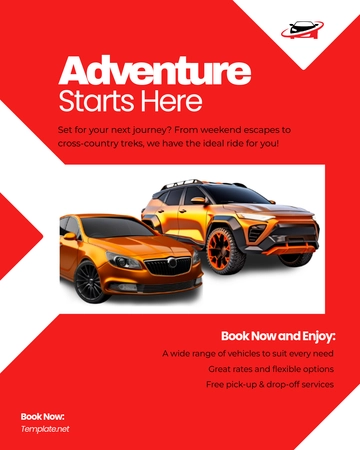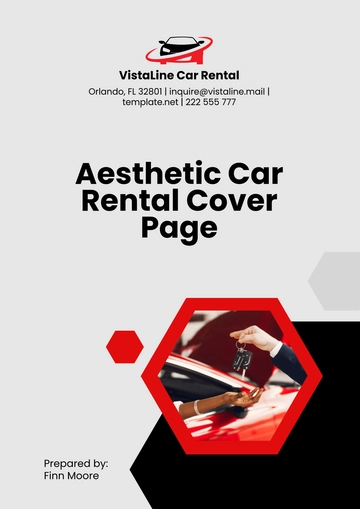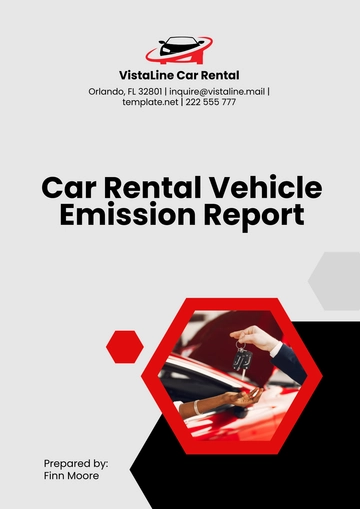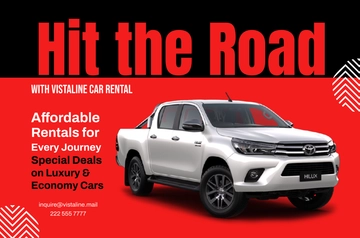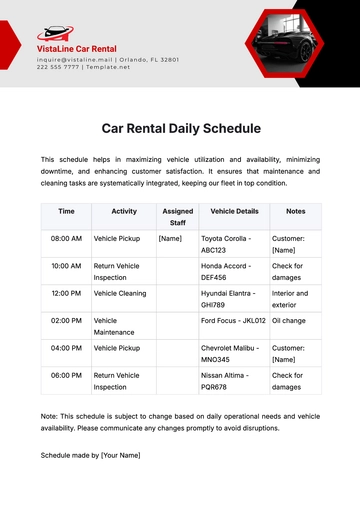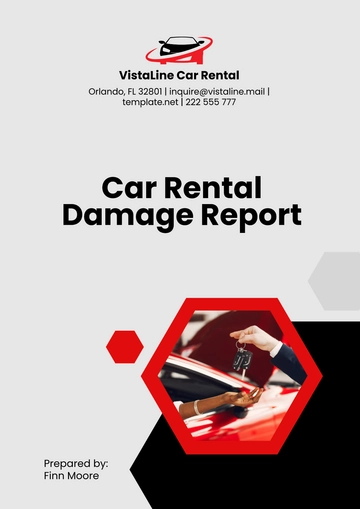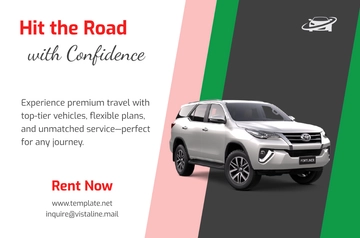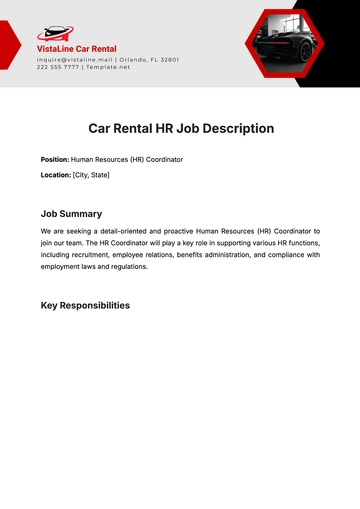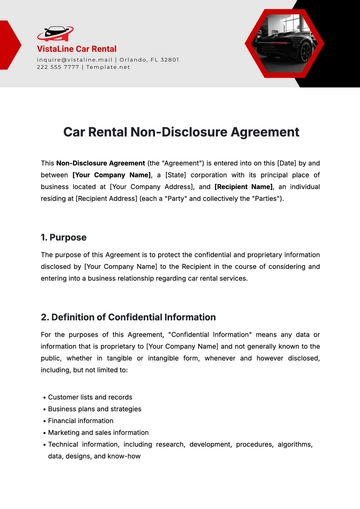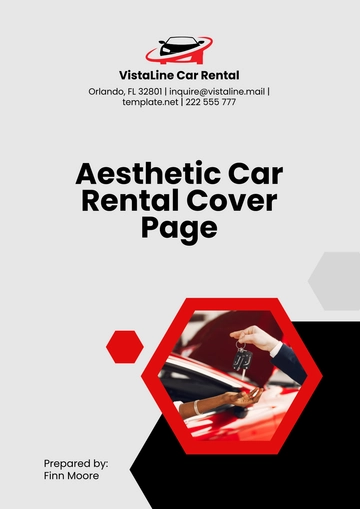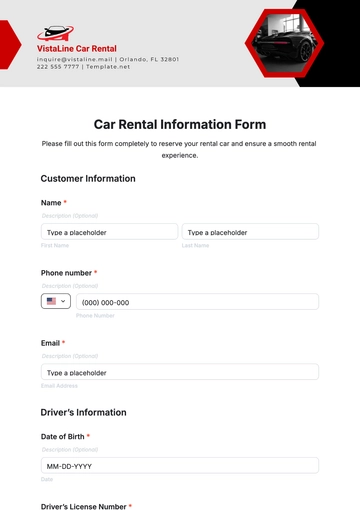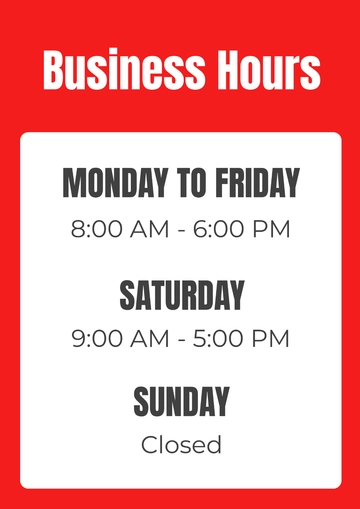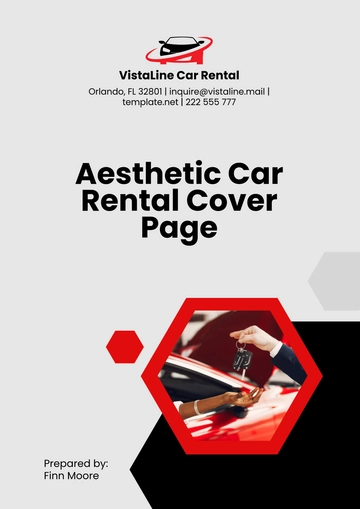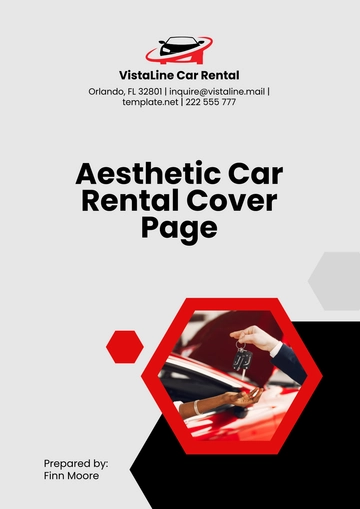Free Car Rental Marketing Guide
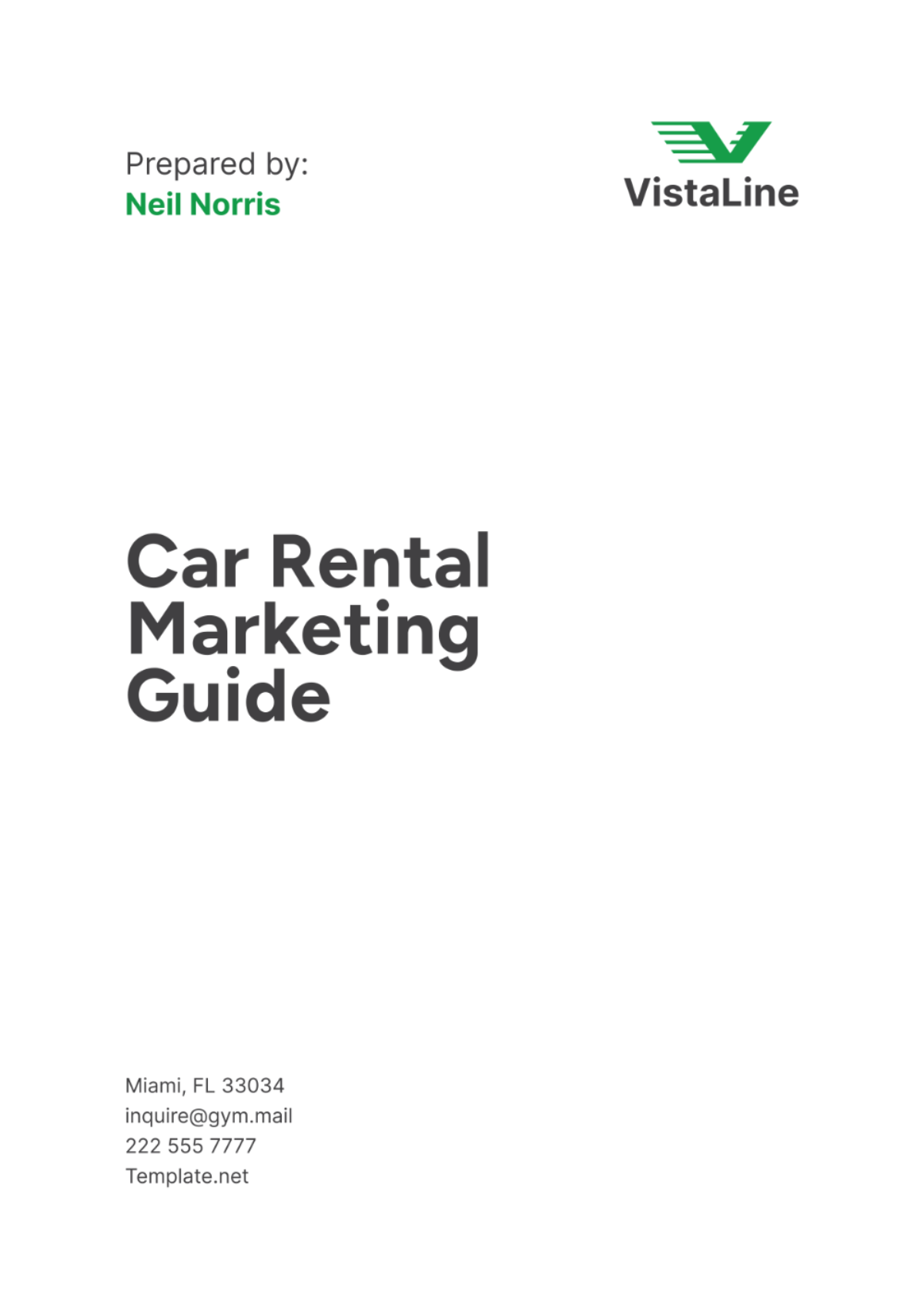
I. Introduction
We are pleased to present [Your Company Name]'s comprehensive Marketing Guide. This strategic document outlines our approach to promoting our diverse range of rental vehicles, from economy cars to luxury SUVs, to meet the varied needs of our customers. Our primary marketing objectives are to increase brand visibility, boost booking rates, and enhance customer loyalty through well-planned marketing initiatives.
By leveraging digital marketing, social media, and traditional advertising, we aim to effectively reach our target audience. Additionally, we will build strong partnerships and collaborations to expand our market reach and support growth. Our ultimate goal is to establish [Your Company Name] as the preferred car rental choice, recognized for quality, reliability, and exceptional customer service.
II. Target Audience
Our diverse target audience comprises business travelers, tourists, and local residents in search of dependable transportation solutions. From budget-conscious customers to those seeking premium services, we cater to a broad demographic with tailored rental options.
Customer Segment | Description | Marketing Approach |
|---|---|---|
Business Travelers | Professionals needing reliable vehicles for corporate travel. | Implement targeted digital campaigns highlighting convenience, flexibility, and corporate benefits. Offer customized packages for frequent business renters. |
Tourists | Visitors seeking hassle-free transportation during their stay. | Focus on promoting scenic routes, GPS navigation services, and vacation packages through tourism websites, blogs, and local partnerships. |
Local Residents | Individuals requiring short-term or alternative transportation solutions. | Emphasize affordability, flexible rental terms, and loyalty programs through community events, local advertising, and partnerships with residential complexes. |
Premium Segment | Customers desiring luxury vehicles with top-tier amenities and services. | Utilize high-end lifestyle magazines, luxury travel platforms, and exclusive partnerships to highlight our fleet's luxury offerings and premium customer service. |
Budget Segment | Cost-conscious consumers looking for economical rental options. | Advertise competitive pricing, discounts for extended rentals, and economic efficiency benefits through targeted online ads, price comparison websites, and local promotions. |
Understanding the distinct needs and preferences of each customer segment enables [Your Company Name] to craft targeted marketing strategies. By aligning our messaging with the specific expectations of business travelers, tourists, local residents, and those seeking premium or budget-friendly options, we ensure effective engagement and increased customer satisfaction.
III. Competitive Analysis
Understanding our competitors' strengths and weaknesses is crucial for positioning [Your Company Name] strategically within the car rental industry. By analyzing key players, we can leverage our strengths and capitalize on market gaps to differentiate our offerings effectively.
Competitor | Strengths | Weaknesses | Market Positioning Strategy |
|---|---|---|---|
Competitor A | Extensive nationwide presence; diverse fleet including eco-friendly options. | Higher pricing compared to industry average; mixed customer service reviews. | Emphasize superior customer service and competitive pricing through targeted promotions and enhanced customer loyalty programs. |
Competitor B | Competitive pricing structure; strong brand reputation among budget-conscious travelers. | Limited luxury vehicle options; challenges with fleet maintenance. | Highlight reliability and affordability while expanding luxury vehicle offerings and investing in fleet maintenance technologies. |
Competitor C | Premium fleet with luxury and exotic car rentals; personalized customer service for high-end clientele. | Limited geographical reach; higher rental rates for premium vehicles. | Focus on expanding geographical footprint and leveraging partnerships to offer exclusive luxury experiences and personalized service enhancements. |
Competitor D | Innovative booking platform with user-friendly interface; focus on tech-driven customer experience. | Limited customer service availability; issues with fleet availability during peak seasons. | Enhance technological infrastructure to improve booking efficiency and invest in customer service training to ensure consistent service excellence. |
By assessing competitors' offerings across fleet quality, pricing structures, customer service, and additional services, [Your Company Name] can strategically position itself as a leader in the market. Leveraging insights gained from this analysis, we will focus on enhancing customer experience, expanding our fleet offerings, and optimizing pricing strategies to reinforce our market position and attract a diverse customer base.
IV. Key Messages
Our key messages are designed to resonate with our target audience by highlighting [Your Company Name]'s core strengths: reliability, affordability, and a diverse selection of vehicles. We prioritize customer satisfaction through seamless booking processes and robust customer support, ensuring a positive rental experience.
Key Message | Description | Implementation Strategy |
|---|---|---|
Reliability | Emphasize our commitment to maintaining a dependable fleet and ensuring vehicles are in top condition for every rental. | Showcase customer testimonials and reliability statistics in marketing materials and on our website. |
Affordability | Communicate competitive pricing structures and value-added benefits such as discounts for extended rentals and seasonal promotions. | Highlight affordability through targeted advertising campaigns on price comparison websites and social media platforms. |
Wide Range of Vehicle Options | Showcase our diverse fleet, catering to various customer preferences from economy cars to luxury SUVs. | Create visually appealing content showcasing our vehicle lineup on our website and through digital brochures distributed via email marketing campaigns. |
Customer Satisfaction | Stress our dedication to providing exceptional customer service, including 24/7 support and personalized assistance throughout the rental process. | Implement a feedback loop to gather customer reviews and use positive testimonials in promotional materials and customer service training programs. |
Seamless Booking Experience | Promote our user-friendly online booking platform and mobile app, ensuring hassle-free reservations and efficient rental management. | Conduct usability tests and implement enhancements based on user feedback to optimize the booking process across all digital platforms. |
By consistently reinforcing these key messages across all marketing channels and customer touchpoints, [Your Company Name] will strengthen its brand identity, build trust with customers, and differentiate itself as a preferred choice in the competitive car rental market.
V. Branding Guidelines
Maintaining a cohesive brand identity is essential for establishing trust and recognition in the market. Our branding guidelines provide clear instructions on the use of logos, color palettes, and typography to maintain consistency across all marketing materials.
Branding Element | Description | Implementation Strategy |
|---|---|---|
Logo Usage | Specify guidelines for proper placement, sizing, and clear space around the logo to ensure visibility and recognition. | Provide downloadable logo files and usage examples for designers and marketers. |
Color Scheme | Define primary and secondary color palettes along with guidelines for digital and print applications to maintain visual coherence. | Create a style guide with color codes and usage scenarios for different platforms and mediums. |
Typography | Outline preferred fonts, sizes, and styles for headings, body text, and digital content to enhance readability and brand consistency. | Share typography guidelines in a document format and include downloadable font files for consistent use across all communications. |
Visual Imagery | Specify preferred styles of photography, graphics, and visual elements that align with the brand's tone and messaging. | Create a library of approved visual assets and provide guidelines for their appropriate use in marketing campaigns and on social media. |
Tone of Voice | Define the brand's voice, including language style, tone, and key messaging points to maintain a cohesive and engaging communication style. | Develop a tone of voice guide with examples of messaging for different audience segments and marketing channels. |
Following these branding guidelines ensures that every communication piece reflects [Your Company Name]'s values and aesthetic consistently. This consistency strengthens brand recognition, fosters trust with customers, and reinforces our market presence, ultimately contributing to long-term customer loyalty and brand growth.
VI. Promotional Strategies
Our promotional strategies encompass a diverse approach integrating digital campaigns, social media engagement, and traditional advertising methods. Leveraging advanced digital tools such as SEO, PPC advertising, and email marketing, we aim to enhance online visibility and drive bookings effectively.
Promotional Strategy | Description | Implementation Strategy |
|---|---|---|
Digital Campaigns | Utilize SEO techniques to optimize website content and improve search engine rankings for relevant keywords, driving organic traffic and conversions. | Conduct keyword research and implement SEO best practices in website updates and content creation. |
Pay-Per-Click (PPC) Advertising | Launch targeted PPC campaigns on search engines and social media platforms to increase ad visibility and drive immediate traffic and bookings. | Develop compelling ad copy, set specific targeting parameters, and monitor campaign performance to optimize ad spend and maximize ROI. |
Email Marketing | Implement segmented email campaigns to nurture leads, promote special offers, and engage with existing customers, encouraging repeat bookings. | Build an email subscriber list, create personalized content based on customer preferences and behavior, and utilize email automation for efficiency. |
Social Media Engagement | Utilize Facebook, Instagram, and Twitter for targeted advertising, customer interaction, and brand storytelling to increase engagement and bookings. | Develop a content calendar with engaging visuals and copy, utilize social media analytics to measure performance, and respond promptly to customer inquiries. |
Partnerships and Collaborations | Forge alliances with travel agencies, hotels, and local businesses to cross-promote services, expand market reach, and attract new customer segments. | Identify strategic partners, negotiate mutually beneficial agreements, and co-host promotional events or campaigns to leverage combined audience reach. |
By integrating these promotional strategies, [Your Company Name] aims to strengthen brand visibility, engage with target audiences effectively, and drive increased bookings and revenue. Each strategy is tailored to optimize customer engagement across digital and traditional channels, fostering sustainable growth and market leadership in the competitive car rental industry.
VII. Budget Allocation
A well-structured budget is crucial for effectively executing [Your Company Name]'s marketing strategies. Our budget allocation focuses on prioritizing high-impact initiatives across various channels to maximize return on investment (ROI) and achieve our marketing objectives.
Channel/Initiative | Budget Allocation (%) | Description | Monitoring and Adjustment Strategy |
|---|---|---|---|
Digital Campaigns | 40% | Investment in SEO, PPC advertising, and email marketing to drive online visibility and bookings. | Monitor campaign performance metrics such as click-through rates (CTR) and conversion rates. Adjust budgets based on performance and ROI. |
Social Media Advertising | 20% | Allocation for targeted ads on Facebook, Instagram, and Twitter to increase engagement and bookings. | Track engagement metrics (likes, shares, comments) and ad performance. Allocate additional funds to high-performing campaigns. |
Traditional Advertising | 15% | Budget for print media, radio, and outdoor advertising to reach local audiences effectively. | Monitor reach and frequency metrics. Shift budgets between different traditional media based on effectiveness and audience response. |
Partnership Collaborations | 15% | Funds for joint promotional activities with travel agencies, hotels, and local businesses. | Evaluate partnership ROI through tracked referral bookings and customer acquisition costs. Adjust investment based on partnership outcomes. |
Miscellaneous Expenses | 10% | Reserve for unforeseen expenses, market research, and ongoing marketing tool subscriptions. | Regular review of miscellaneous expenses against budgeted allocations. Adjust based on emerging needs and opportunities. |
Regular monitoring and adjustment of our budget allocation will ensure flexibility to capitalize on emerging opportunities and address challenges promptly, optimizing our marketing spend effectively.
VIII. Success Metrics
Defining clear success metrics is essential for measuring the effectiveness of [Your Company Name]'s marketing efforts. Key performance indicators (KPIs) such as website traffic, booking rates, conversion rates, and customer satisfaction scores will provide valuable insights into our strategies' impact.
Key Performance Indicator | Measurement Method | Description | Action Plan |
|---|---|---|---|
Website Traffic | Google Analytics | Track monthly unique visitors, page views, and bounce rates to gauge website engagement. | Optimize SEO and content strategies based on traffic patterns. |
Booking Rates | Booking System Metrics | Monitor the number of reservations and booking conversion rates from different marketing channels. | Adjust marketing budgets and strategies to focus on high-converting channels. |
Conversion Rates | CRM Analytics | Measure the percentage of website visitors who convert into paying customers. | A/B test landing pages and promotional offers to optimize conversion rates. |
Customer Satisfaction Scores | Surveys and Feedback | Regularly survey customers post-rental to assess satisfaction levels and gather feedback. | Implement improvements based on feedback to enhance customer experience. |
Return on Investment (ROI) | Financial Analysis | Calculate ROI for each marketing initiative by comparing costs to revenue generated. | Allocate resources to initiatives with higher ROI and adjust budgets accordingly. |
Regular analysis and review of these success metrics will guide [Your Company Name] in refining marketing approaches, optimizing campaigns, and ensuring sustained growth and customer satisfaction in the competitive car rental market.
IX. Conclusion
This comprehensive marketing guide outlines [Your Company Name]'s strategic approach to enhancing market visibility and customer engagement in the car rental industry. By meticulously implementing the strategies outlined herein, we aim to solidify our brand presence, increase booking rates, and cultivate lasting customer loyalty.
Our commitment to delivering exceptional service and meeting customer expectations drives every facet of this plan. [Your Company Name] is poised to establish itself as the premier choice for car rentals, distinguished by our commitment to quality, reliability, and unparalleled customer care.
Through continuous evaluation and adaptation of our marketing initiatives, we will remain agile and responsive to market dynamics and customer preferences. By adhering to this guide, we are confident in achieving sustained growth, expanding our market share, and delivering unparalleled value to our clientele.
- 100% Customizable, free editor
- Access 1 Million+ Templates, photo’s & graphics
- Download or share as a template
- Click and replace photos, graphics, text, backgrounds
- Resize, crop, AI write & more
- Access advanced editor
Unlock the potential of your car rental business with the Car Rental Marketing Guide Template from Template.net. This fully customizable and editable template is designed to elevate your marketing strategy effortlessly. With our Ai Editor Tool, you can tailor every detail to your specific needs, making it the perfect solution for marketing professionals aiming for excellence.

